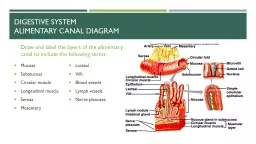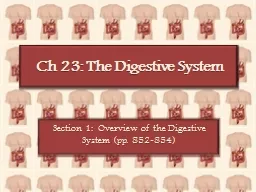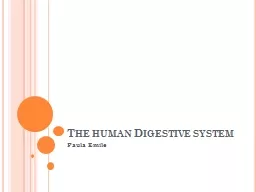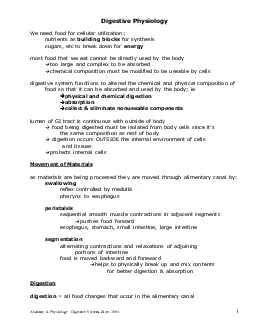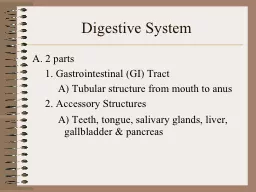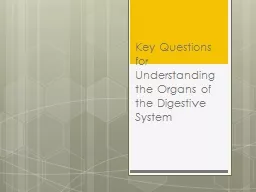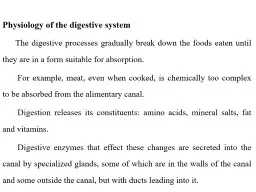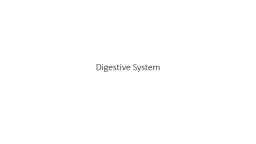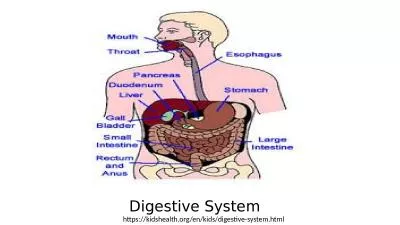PPT-Digestive System: Alimentary Canal
Author : olivia-moreira | Published Date : 2018-03-21
Metallic 0 Mind Mucsularis mucosae surround lamina propria and composed of Inner circular layer Outer longitudinal layer Mucosa Lined by epithelium Deep is
Presentation Embed Code
Download Presentation
Download Presentation The PPT/PDF document "Digestive System: Alimentary Canal" is the property of its rightful owner. Permission is granted to download and print the materials on this website for personal, non-commercial use only, and to display it on your personal computer provided you do not modify the materials and that you retain all copyright notices contained in the materials. By downloading content from our website, you accept the terms of this agreement.
Digestive System: Alimentary Canal: Transcript
Metallic 0 Mind Mucsularis mucosae surround lamina propria and composed of Inner circular layer Outer longitudinal layer Mucosa Lined by epithelium Deep is a loose connective tissue . Metallic. 0 . Mind. Mucsularis. . mucosae. . surround lamina . propria. and composed of :. Inner circular layer.. Outer longitudinal layer. Mucosa:. Lined by epithelium.. Deep is a loose connective tissue (. By Mr. Style. Parts of the Digestive System. The Mouth:. The . mouth is the beginning of the digestive system, and, in fact, digestion starts here before you even take the first bite of a meal. The smell of food triggers the salivary glands in your mouth to secrete saliva, causing your mouth to water. When you actually taste . Essential Question. What are the structures of the digestive system?. 2.07 Remember the structures of the . digestive . system. 2. Structures of the digestive system. Digestive system. Also known as:. A. Bacterial Diseases of the Upper Digestive Tract (Mouth & Stomach). 1. Tooth Decay (dental caries). A) This is an endogenous infection . 1) Most common infectious disease of humans . 2) Young are more susceptible than old. ALIMENTARY CANAL DIAGRAM. Draw and label the layers of the alimentary canal to include the following terms:. Mucosa. Submucosa. Circular muscle. Longitudinal muscle. Serosa. Mesentery. Lacteal. Villi. Section 1: Overview of the Digestive System (pp. 852-854). Two groups of organs. :. . 1) . Alimentary. canal. . - also known as . gastrointestinal. or . GI. tract. . - . digests. & . Paula Emile. Learning Outcomes. identify the gross structure of the alimentary canal and associated organs (mouth, . oesophagus. , stomach, small intestine: duodenum and ileum, large intestine: colon and rectum, anus, pancreas, liver). Created by Ashley Berryhill. Digestive System. AKA gastrointestinal system or GI system. Function. =responsible for the physical & chemical breakdown of food so it can be taken into bloodstream & be used by body cells & tissues. pharynx to esophagus all food changes that occur in the alimentary canalAnatomy Physiology Digestive System Ziser 2003breaking large molecules proteins fats starches etca thick coating of bicarbona 1. Gastrointestinal (GI) Tract. A) . Tubular . structure from mouth to anus. 2. Accessory Structures. A) . Teeth. , tongue, salivary glands, liver, gallbladder & pancreas. Digestive System. B. 6 basic processes. 1. What are the 2 groupings of the digestive organs?. The alimentary canal. The accessory digestive organs. 2. What are the functions of the alimentary canal?. It ingests and digests food, absorbs nutrients, and defecates wastes. The digestive processes gradually break down the foods eaten until they are in a form suitable for absorption.. For example, meat, even when cooked, is chemically too complex to be absorbed from the alimentary canal.. to convert food into nutrients your body needs, and to rid the body of waste. . To do its job, the system requires the cooperation of a number of different organs throughout the body, including the mouth, stomach, intestines, liver and gallbladder. The digestive system has . three main . functions: . to convert food into nutrients your body . needs. Absorption. R. id . the body of . waste. To . do its job, the system requires the cooperation of a number of different structures and organs throughout the body, including the mouth, stomach, intestines, liver, pancreas and gallbladder..
Download Document
Here is the link to download the presentation.
"Digestive System: Alimentary Canal"The content belongs to its owner. You may download and print it for personal use, without modification, and keep all copyright notices. By downloading, you agree to these terms.
Related Documents





